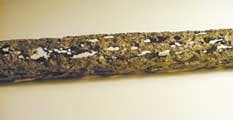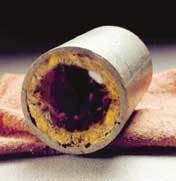Protection Key to Boiler Performance
By Glen P. Sundstrom
Many factors should be considered in selecting appropriate boiler feedwater treatment equipment. Operators and engineers need to heed the boiler manufacturer's suggested feedwater quality, which is based on either the boiler water quality or, in many cases, the produced steam quality. Capital costs, operating costs, chemical handling and waste treatment also need to be factored into the decision.
Of equal importance is protecting and maintaining the equipment, once installed. Equipment users need to understand how to improve and control the boiler feedwater as well as reduce maintenance and system downtime costs. But in order to do so effectively, they must recognize and remedy the three most frequent problems affecting boilers, steam and condensate systems: scaling, corrosion and oxidation.
Scale
Feedwater scale is commonly comprised of calcium carbonate and magnesium carbonate, or hardness. Although other scales can form in boilers, hardness is by far the most prevalent. These carbonate precipitates are usually deposited on, or in, the boiler tubes, creating an insulating barrier to the heat transfer process. As a result, higher temperatures are needed to produce the same steam output. Catastrophic metal failures, due to excessive temperatures, may occur when deposits are extremely heavy.
Hardness can easily be removed by using traditional softening techniques. Lime softening precipitates the hardness with lime, while ion exchange (or zeolite) softening removes the hardness ions and replaces them with sodium ions.
Corrosion
Corrosion is normally caused by excessive alkalinity in the feedwater. In this instance, the carbonate and bicarbonate alkalinity converts to carbon dioxide in the boiler, and is then expelled with the steam. As the steam condenses, the carbon dioxide dissolves in the condensate, creating carbonic acid. Other impurities in the condensate are typically very low, allowing the pH value to decrease substantially, causing corrosion in such areas as steam traps, heat exchangers, piping, receivers and pumps. If severe corrosion takes place, the built-up corrosion products can eventually prevent the feedwater from flowing through any of these devices.
Removing alkalinity is fairly simple by employing such tried and true mechanisms as pH adjustment followed by a forced draft decarbonator, or ion exchange with anion resins (a.k.a. dealkalization). With the first technique, the alkalinity is converted to carbon dioxide and is then removed by air stripping. The second involves replacing the alkalinity with the chloride ion. A third alternative includes injecting amines into the feedwater to prevent the corrosion products from forming on steel surfaces.
Oxidation
When dissolved oxygen is present in the feedwater, oxidation, or rusting, occurs. As steel oxidizes, metal is removed from the surface. Prolonged exposure to an oxidative environment can cause pinholes to form first in the boiler tubes, and then in the other steam and condensate handling equipment mentioned earlier.
Since the levels of dissolved oxygen are generally very low, the use of oxygen-scavenging chemicals is one of the most common and cost-effective methods currently employed.
Other Treatment Options
Specialty treatment chemicals can also be used in conjunction with boiler feedwater treatment equipment, and are injected into the boiler feedwater. Antiscalants and dispersants prevent scale from forming and/or depositing; corrosion inhibitors adhere to the steel surfaces and protect them from the effects of corrosive conditions; and amines neutralize carbonic acid and prevent corrosion.
As the operating pressure of boilers increases, so too does the quality of the feedwater, meaning less hardness, alkalinity and total dissolved solids. In such instances, a demineralization or deionization system comprised of cation and anion exchange columns is commonly used to achieve the desired boiler feedwater quality. Sulfuric or hydrochloric acid and caustic are used in this process to completely remove all dissolved solids, hardness and alkalinity. For many feedwater sources, reverse osmosis (RO) may be the most reliable and economical technology for the removal of dissolved solids, hardness and alkalinity. Unlike deionization, RO does not require regeneration with acids or caustic.
Conclusion
Boilers, steam and condensate systems are big investments and, as a result, they need to be carefully selected, operated and maintained. All too frequently, operators fail to closely monitor the boiler feedwater quality or fully understand the effects of water chemistry on boiler performance. Equipment users that take corrective and preventive measures today will save time, money and untold aggravation in the future.
About the Author Glen P. Sundstrom is a product manager for industrial process water systems at USFilter's facility in Rockford, IL. He is responsible for overseeing the development and marketing of new products for various industrial markets, including Power, HPI/CPI, and Pulp & Paper. Since joining USFilter in 1984, Glen has written several papers on reverse osmosis, and he is a frequent contributor to USFilter's quarterly HPI/CPI newsletter, Solutions. Glen has a BS degree in Chemical Engineering from the University of Wisconsin.


